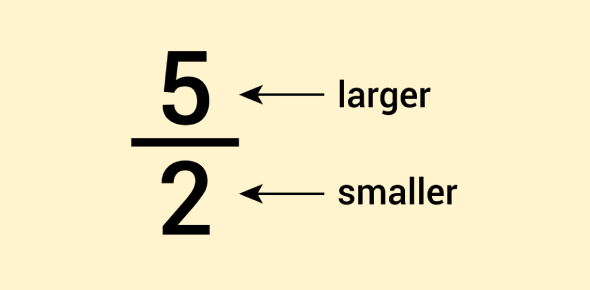What Is Fractions Greater or Less Than Comparison Methods and Examples? Explore Its Types, Uses & More
Lesson Overview
- What Are Fractions, and Why Do They Matter?
- How Do We Compare Fractions with Like Denominators?
- Why Is Comparing Fractions with Like Numerators Easier?
- How Can You Compare Fractions with Unlike Denominators?
- How Do Benchmark Fractions Simplify Comparison?
- Difference Between Improper Fractions and Mixed Numbers
- How Do Visual Representations Clarify Fraction Comparison?
- What Common Mistakes Should You Avoid?
- How Can You Apply Fraction Comparisons to Real-Life Situations?
- Practice Problems to Master Fractions Greater or Less Than
Julie faced confusion in his math exam, unsure how to quickly identify fractions greater or less than others. Such uncertainty cost him precious time. Understanding fractions greater or less than will solve this issue, enabling you to swiftly analyze, compare, and confidently determine fractional values in your academic pursuits.
What Are Fractions, and Why Do They Matter?
Imagine ordering a pizza with friends and dividing it evenly to ensure fairness. Fractions precisely express such divisions, representing a part of a whole. They consist of two essential components: the numerator and denominator.
- The numerator indicates the selected number of equal parts.
- The denominator represents the total equal parts making up a whole.
Understanding fractions allows precise measurements, which is critical in science, engineering, medicine, and daily life. For instance, chemists use fractions for concentrations, engineers for measurements, and cooks for recipes.
How Do We Compare Fractions with Like Denominators?
When fractions share the same denominator, comparing their values becomes straightforward. Simply inspect their numerators.
Fractions with identical denominators indicate segments of equal-sized pieces. Thus, a larger numerator means selecting more equal parts, inherently making the fraction greater.
Example
Compare 3/8 and 7/8:
- Both fractions divide a whole into eight equal segments.
- Selecting three segments (3/8) is obviously less than selecting seven segments (7/8).
- Hence, 3/8 < 7/8.
Why Is Comparing Fractions with Like Numerators Easier?
When fractions have equal numerators but different denominators, larger pieces result from fewer total parts.
Scientific Explanation
A smaller denominator implies larger portions because dividing something into fewer parts produces larger individual segments.
Example
Consider 2/3 vs. 2/5:
- Numerators are identical, each fraction selecting two segments.
- The denominator 3 indicates larger segments than denominator 5.
- Hence, 2/3 > 2/5.
How Can You Compare Fractions with Unlike Denominators?
This scenario demands greater analysis and systematic methods such as cross-multiplication and common denominators.
Cross-Multiplication Method
Cross-multiplication involves multiplying numerators and denominators diagonally, producing whole numbers for quick comparison.
- Example: Compare 4/7 and 3/5.
- Calculation: (4 × 5) = 20; (3 × 7) = 21.
- Since 20 < 21, 4/7 < 3/5.
Common Denominator Method
Find the least common denominator (LCD) to create comparable fractions.
- Example: Compare 1/4 and 2/5.
- The LCD of 4 and 5 is 20.
- Converting fractions: 1/4 = 5/20 and 2/5 = 8/20.
- Hence, 5/20 < 8/20, thus 1/4 < 2/5.
How Do Benchmark Fractions Simplify Comparison?
Benchmark fractions like 1/2, 1/4, and 3/4 facilitate rapid mental comparisons. They simplify estimating values without detailed calculations.
Practical Usage
Benchmarks are useful in scenarios requiring quick estimation rather than precise calculation.
Example
Compare 5/9 and 4/7 to 1/2:
- 1/2 is equivalent to 0.5.
- Convert 5/9 ≈ 0.555; convert 4/7 ≈ 0.571.
- Both fractions exceed 1/2, with 4/7 slightly greater than 5/9.
Difference Between Improper Fractions and Mixed Numbers
Improper fractions have numerators larger than denominators, while mixed numbers combine whole numbers with proper fractions. Understanding their differences enhances accuracy in comparisons.
Converting Improper Fractions
Convert improper fractions into mixed numbers to simplify comparison.
- Example: Convert 11/4 into a mixed number.
- Division: 11 ÷ 4 = 2 remainder 3, hence 11/4 = 2 3/4.
How Do Visual Representations Clarify Fraction Comparison?
Visual representations offer intuitive understanding, significantly enhancing comprehension through diagrams or number lines.
Number Lines
Number lines visibly show relative positions of fractions, providing direct comparison.
Area Models
Shapes partitioned into fractions illustrate clearly how much of the whole each fraction occupies.
Example
Representing 2/5 and 1/2 visually quickly shows 1/2 as greater due to more shaded areas.
What Common Mistakes Should You Avoid?
Students often overlook common denominators or mistakenly assume greater numerators indicate larger fractions without considering denominators.
- Avoid direct numerator comparisons unless denominators match.
- Ensure precise calculations during conversions.
- Always simplify fractions before final comparisons.
How Can You Apply Fraction Comparisons to Real-Life Situations?
Understanding fractions greater or less than extends beyond the classroom into practical life scenarios.
- Cooking: Recipe adjustments involve accurate fraction comparisons to maintain proportions.
- Budgeting: Fractional calculations assist in understanding discounts or price differences.
- Science Labs: Accurate measurements rely heavily on fraction precision to maintain experiment integrity.
Practice Problems to Master Fractions Greater or Less Than
- Compare 7/12 and 5/8:
- Common denominator 24: 7/12 = 14/24, 5/8 = 15/24.
- Result: 7/12 < 5/8.
- Common denominator 24: 7/12 = 14/24, 5/8 = 15/24.
- Which fraction is greater: 4/9 or 3/7?
- Cross-multiply: (4 × 7 = 28), (3 × 9 = 27).
- Result: 4/9 > 3/7.
- Cross-multiply: (4 × 7 = 28), (3 × 9 = 27).
- Arrange from least to greatest: 3/4, 7/10, 2/3:
- LCD: 60; 3/4 = 45/60, 7/10 = 42/60, 2/3 = 40/60.
- Result: 2/3 < 7/10 < 3/4.
- LCD: 60; 3/4 = 45/60, 7/10 = 42/60, 2/3 = 40/60.
Rate this lesson:
 Back to top
Back to top

